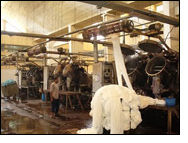Interviews
B'desh textile units gain from sustainable practices
03 Apr '12
3 min read

Textile processing units of Bangladesh garment companies are adopting cleaner production (CP) practices, which is helping them save a lot of money as well as to become more competitive.
Twelve apparel manufacturers, including the DBL Group, ABA Group, Fakir Knitwear, Multifabs, SF Fashion and Tarasima Apparels have introduced CP practices at their textile processing units.
The 12 factories were provided technical assistance by the South Asia Enterprise Development Facility (SEDF), which is managed by the International Finance Corporation (IFC).
After investing around US$ 210,000 on CP technologies, the twelve units have together saved about US$ 568,000 or more than 250 percent in the first year of introduction of environment-friendly production technologies.
According to an IFC report on the benefits of CP practices, returns on investments may go up to 550 percent in the initial three years after adoption of sustainable technologies.
The CP system involves use of improved technologies that reduce consumption of water, energy and other resources. It also results in decreased amounts of carbon emission and waste generation. Thus, it helps textile processing units to substantially cut-down on their costs.
There are about 1,700 washing, dyeing and finishing factories in Bangladesh that discharge 56 million tons of toxic waste each year, which necessitates urgent action for introduction of environment-friendly production practices in Bangladeshi textile manufacturing units, according to the IFC report.
IFC stated that the 12 factories at which CP practices were introduced, saved about 6,200 million cu m of gas, 1.33 gigawatt-hour of electricity and 75,000 million cu m of water.
This has encouraged SEDF to partner with six more units to help them adopt CP practices at their units this year.
“We have adopted the cleaner production practices with help from the IFC and we have been successful in setting up a model factory in Bangladesh. The CP practice is mainly about using fewer resources for production in order to reduce carbon emissions. It also involves decreasing the usage of water, energy, and other resources,” Mr. MA Jabbar, Managing Director of DBL Group, one of the firms to introduce the CP concept in beginning of 2011, told fibre2fashion.
“Under the programme, we first identified what we were doing and its impact on the environment. Then we monitored and implemented techniques to reduce the impact. For example, we earlier used 120 litres of water for dyeing purposes, and now we are using 70 litres. So, we are now saving 50 litres of water,” he explains.
“Overall, we have been able to reduce our consumption of gas by 18 percent, electricity by 13 percent, and water by 13 percent while increasing our production by 14 percent and reducing carbon emissions by 17 percent during January-September 2011 compared to corresponding months of 2010,” he reveals.
Twelve apparel manufacturers, including the DBL Group, ABA Group, Fakir Knitwear, Multifabs, SF Fashion and Tarasima Apparels have introduced CP practices at their textile processing units.
The 12 factories were provided technical assistance by the South Asia Enterprise Development Facility (SEDF), which is managed by the International Finance Corporation (IFC).
After investing around US$ 210,000 on CP technologies, the twelve units have together saved about US$ 568,000 or more than 250 percent in the first year of introduction of environment-friendly production technologies.
According to an IFC report on the benefits of CP practices, returns on investments may go up to 550 percent in the initial three years after adoption of sustainable technologies.
The CP system involves use of improved technologies that reduce consumption of water, energy and other resources. It also results in decreased amounts of carbon emission and waste generation. Thus, it helps textile processing units to substantially cut-down on their costs.
There are about 1,700 washing, dyeing and finishing factories in Bangladesh that discharge 56 million tons of toxic waste each year, which necessitates urgent action for introduction of environment-friendly production practices in Bangladeshi textile manufacturing units, according to the IFC report.
IFC stated that the 12 factories at which CP practices were introduced, saved about 6,200 million cu m of gas, 1.33 gigawatt-hour of electricity and 75,000 million cu m of water.
This has encouraged SEDF to partner with six more units to help them adopt CP practices at their units this year.
“We have adopted the cleaner production practices with help from the IFC and we have been successful in setting up a model factory in Bangladesh. The CP practice is mainly about using fewer resources for production in order to reduce carbon emissions. It also involves decreasing the usage of water, energy, and other resources,” Mr. MA Jabbar, Managing Director of DBL Group, one of the firms to introduce the CP concept in beginning of 2011, told fibre2fashion.
“Under the programme, we first identified what we were doing and its impact on the environment. Then we monitored and implemented techniques to reduce the impact. For example, we earlier used 120 litres of water for dyeing purposes, and now we are using 70 litres. So, we are now saving 50 litres of water,” he explains.
“Overall, we have been able to reduce our consumption of gas by 18 percent, electricity by 13 percent, and water by 13 percent while increasing our production by 14 percent and reducing carbon emissions by 17 percent during January-September 2011 compared to corresponding months of 2010,” he reveals.
Fibre2fashion News Desk - India
Popular News
































-Ltd..jpg?tr=w-120,h-60,c-at_max,cm-pad_resize,bg-ffffff)





.jpg?tr=w-120,h-60,c-at_max,cm-pad_resize,bg-ffffff)
.jpg?tr=w-120,h-60,c-at_max,cm-pad_resize,bg-ffffff)






